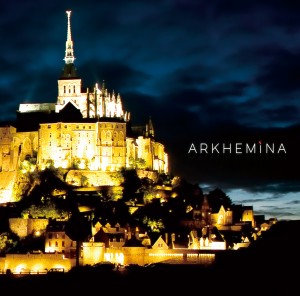ARKHEMINA
 |
Album Title: ARKHEMINA |
| Record Label: ARKHEMINA Records |
|
| Catalog No.: DSDA-00001 |
|
| Release Date: November 6, 2014 |
|
| Purchase: Download from Official Site |
Overview
ARKHEMINA is a album composed by husband-and-wife duo Masamichi Seki and Minako Seki, the latter the composer of the Tales Drama CDs as well as Berwick Saga and Yazuka 4. The album draws heavily on classical influences from various eras of history in European music to create a series of pieces, each one named after a castle in Western Europe. Because each piece is representative of such a specific setting, the time period or composer represented is the result of a thematic choice. The resulting album is a beautiful array of classical-fusion pieces, blending with electronic effects or synth instruments that give the album a nouveau classique feel.
Body
“Mont Saint-Michel” represents the castle on the cover of ARKHEMINA, the famous fortified monastery on an island protected by shifting tides. The piece opens with lightly repeated piano notes in an echo-like effect and quickly increases in dramatics through liberal use of percussion and strings, along with a constant choir featuring male vocals that very faintly reflects the sounds of a monastery in the dark ages. The shift from piano to heavier percussion and vocals perhaps suggests the lowering of the tide, allowing access to the ancient monastery. A piccolo later joins the odd myriad of instruments, reflecting the occasional militant roles Saint-Michel has fulfilled over the course of the years. The choir continues ceaselessly adding its own layer to the piece, reminding the listener of the original monastic nature of the island. Finally, the piano takes over again, as the tide rises back up around the island and shuts off access to the ancient monetary.
The castle of “Chateau d’Amboise” was inhabited by members of the Medici family during the Italian Renaissance Era, and is even the burial place for Leonardo da Vinci. One reference to the Renaissance time period of the castle is the frequent use of the guitar in the piece which alternates with strings, percussion, and a full choir’s worth of vocals. The choir is carefully arranged so no one voice stands out, and the instrumentation is carefully arranged so that the various lines of music are fluidly moving from forefront to background.
“Chateau de Villandry,” based on a castle widely known for its grand-scale gardens, opens with an intricate piano pattern, followed by a chorus of vocals and strings. The piece becomes calmer and more relaxed with an extremely laid-back percussive beat and a solo trumpet playing an almost lounge-style melody crossed with the soundtrack of a nineties film. While the choir enters and leaves, bringing occasional moments of stronger solemnity, the piece is overall a casual one, perhaps reflecting a thoughtful stroll through the green Villandry gardens.
Easily my favorite nod to the history and culture of the castles is in the tracks “Schloss Hohenschwangau” and “Schloss Neuschwanstein,” two German castles — almost Austrian in geography — with a particularly interesting connection to music history. King Ludwig II of then-Bovaria was a major patron of contemporary composer Richard Wagner, and additionally was an avid fan and friend. Such a huge fan, in fact, that he even had private showings of Wagner’s operas in his home of Hohenschwangau, a blocky, sprawling castle. Neuchwanstein, on the other hand, was later built as a sort of fantasy get-away for Ludwig (with Wagnerian elements in mind), and was later used as the iconic Sleeping Beauty castle in Disneyworld. Wagner was famous (or infamous?) for his strong belief in the use of a full orchestra, which included not only a full range of instruments but vocals and concert halls designed specifically for the acoustics of his own works. In turn, the two pieces are aptly constructed using a myriad of orchestral elements, from the archaic harpsichord to a single female using more current effects in order to emulate the echoes of a piece being sung in a stone hall.
“Hohenschwangau” begins with a light series of strings with a few descending chords not entirely unlike small portions of the Wagner’s Tannhauser Overture. While Wagner is by no means my favorite classical composer, I loved the gentle nods made to both the composer and his flamboyant, artistically inclined patron. The piano that comes in after the initial strings is whimsical before the strings come back in, in the same manner as the beginning of the piece, but with more force, rising and falling dramatically with rippling piano and foundational brass. “Hohenshewangau” seems to be ending with the orchestral fanfare but suddenly breaks into a Renaissance-style motet with a beautiful mezzo-soprano and basso continuo harpsichord before the piano returns and ends the piece.
“Neuschwanstein” is much more haunting and otherworldly, with harpsichord, female chorus, and pipes playing in a minor scalar pattern. Because of the strange collection of instruments mixed with electronics, “Neuschwanstein” sounds like a piece out of a fantasy movie; soon, heavier percussion jumps in and the strings begin a much more energetic pattern alongside a catchy — yet no less ethereal — melody. One thing that I particularly love about this piece is its conglomerate nature — the piece is constantly shifting styles, and each section sounds vaguely familiar, but moves on just before the listener has a chance to place the memory.
Summary
ARKHEMINA is a wonderfully innovative album overall, with a refreshingly new approach to thematic arrangement and orchestration. If relatively small portions of the tracks border on kitschy every once in a while with synth pianos or added audio effects, the majority of the album is rich and beautiful. Particularly along with a guide to, or at least pictures of, each of the castles, the pieces are extremely fun to listen to and combine elements of a hugely diverse series of musical styles to create a fantastic thematic album.
Do you agree with the review and score? Let us know in the comments below!
4
Posted on April 1, 2015 by Emily McMillan. Last modified on April 1, 2015.















Great review and very informative. Love how you combined considerations of the music and visuals here.